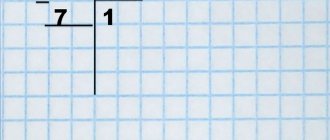Techniques for writing division of a multi-digit number by a single-digit number. Mathematics: 4th grade
Techniques for the written division of a multi-digit number by a single-digit number (for blind and visually impaired children)
Mathematics: 4th grade Lesson objectives: 1. To introduce students to the written technique of dividing a multi-digit number by a single-digit number; 2. Repeat previously studied material about the action of division; 3. Improve computational and problem-solving skills. Equipment : table “Division algorithm”, cards with arithmetic puzzles.
Course of the lesson
I. Organizational moment: Mathematics, friends, it’s impossible not to love. A very exact science, This mathematics! Teacher. Today I invite you on a journey through the country of “Mathematical calculations”. II. Verbal counting. Teacher. Let's begin, our first stop in the city is “Oral Calculations” Stop “Znaykino” 7 * 7 9 * 8 6 * 9 4 * 7 8 * 8 5 * 9 81: 9 54: 6 42: 7 48: 8 27: 3 32: 4 Girls and boys live in this city. They count without difficulty, without calculators or fingers. We invite you guys to quickly count too. 1. Place the signs: 426 * 70 = 356 65 * 4 = 260 714 * 7 = 102 7108 * 0 = 7108 478 * 1 = 478 824 * 8 = 103 2. Arithmetic puzzles: 3. Geometric material. Stop "Figurkino" Teacher. Count how many triangles and quadrilaterals are there in this rectangle? Children. This rectangle has 2 triangles and 10 quadrangles. Teacher. Fine! Let's travel further. III. Lesson topic message. Teacher. Next stop in the city “Written calculations” Look at the board to see which examples you had difficulty with division 42:2 76: 2 96: 3 102: 3 55: 5 75: 5 Children: 76: 2; 102:3; 75:5 Teacher: Right, what do you think we will do in class? Here it's the other way around. They're keeping a serious score here. They write in columns everywhere on the floor and on the table, and smart kids keep count in their notebooks. Children: Divide by a single digit number in a new way Teacher. Before we get started, let's remember the names of the division components. Children. Dividend, divisor, frequent. Teacher. When dividing with a remainder, what should we not forget? Children. The remainder must be less than the divisor. Teacher. The topic of our lesson is directly related to the written technique of dividing a multi-digit number by a single-digit number. Teacher . First, let us recall the written method of dividing a three-digit number by a single-digit number. I offer one of you the role of teacher. Explain how to do division: 768: 2 (Student performs division with explanation at the board) Teacher. The mechanism for dividing multi-digit numbers by a single-digit number does not change. See for yourself. Work from the textbook p. 78. Teacher . You must always remember that the remainder must be less than the divisor. Now we have to divide 9522: 6. Reasoning is carried out and at the same time a division algorithm is compiled. Teacher. I divide thousands, the first incomplete dividend is 9, which means the quotient will have four digits. 9 divided by 6 turns out to be 1 - so many thousands will be in the quotient. (children studying using the Braille system, after writing an example in the second line, take away the first incomplete divisor 9 without a digital sign, when dividing by 6, select a number less than 9, but divisible by 6 and write the found number in line 3 (6), reason 6:6 in the quotient we write 1). I multiply 1 by 6, I get 6 thousand. I subtract the number 6 from 9, I get the remainder 3, it is less than the 6 divisor. (The number 3 is written in the second line “after 9, through a cell without a digital sign,” 5 is taken down next to it, the number 35 is the second incomplete dividend, I divide 35 by 6, I get 5 hundreds in the quotient. I multiply 5 by 6, I get 30 hundreds (this number is written in line 3, after 6). I subtract 35 from 30, I get a remainder of 5 (the remainder of 5 is written in line 2). I compare the remainder with the divisor: 5 is less than 6.( the third digit from the number is added to 5, this is 2) The third incomplete dividend 52 is formed, I divide 52 by 6, I get 8 tens in the quotient. I multiply 8 by 6, I get 48 tens (the number is written in the third line). I subtract 52 from 48, I get the remainder is 4, it is less than the divisor. (I add the last digit from the number 9522 to 4, this is 2) The fourth incomplete dividend 42 is formed, I divide it by 6, I get 7 units in the quotient. I multiply 7 by 6, I get 42 units. (This number is written under the number 42) I subtract 42 from 42, I get a remainder of 0. The division is over. For us, this example will have this form 9522: 6 = 1587 9 35 52 42 0 6 30 48 42 The division algorithm is posted on the board. We select the incomplete dividend. By division we find the number of the quotient. We multiply and find out how much we divided. We subtract and find the remainder. The remainder is compared with the divisor. IV. Consolidation of new material. Game “I can count and I can explain.” Work according to textbook No. 389. V. Physical education. Small steps one, two, three. Light jumps one, two, three. That's it, charge one, two, three. Soft landing one, two, three. VI. Stop city “Mathematical problems”. 1.Teacher . Every city has libraries. We have it in our city too. Tell me, please, how do you handle books? (Students' answers) Teacher. Diligent guys, seeing a torn book, will always repair it. You are given a task on this topic. Let's read problem No. 390. Teacher . What does the problem say? Children. The problem is about a library and book repair. Teacher. What words will we use to make a short note? Children. October, November, December. Teacher . Let's read the main question of the problem. Can you immediately answer the main question? Children. No. Teacher. What do we know about the problem? Children. We know how many books were repaired in three months and how many were repaired in October and November, Teacher . Knowing how many books were repaired in three months and how many were repaired in October and November, what can we find? Children. We can find how many books were repaired in December. Teacher . Now we can consider another pair, which one? Children. Knowing how many books were repaired in November and December and how many were repaired in December, you can find how many books were repaired in November. Teacher. What month is left to find? Children. Knowing how many books were repaired in October and November, we will find how many books were repaired in October. Teacher. How can we check whether we answered the main question of the problem correctly? Children. Add up all three months and compare the result. 2. Solution of problem No. 391. Oral analysis of the problem, posing a question. Teacher. What does 2/7 mean? Children. The whole part was divided into seven parts and only two of them were taken. VII. Stop in the city of “Samodelkino”. 1.Work on options. Task No. 392. Option I – 1 line. Option II – line 2. 2. Solve the equation (cards). x * 7 = 100 – 44 x + 17 = 96 – 58 Don’t forget that first the left side is rewritten, and the right side is considered Mutual check of work. VIII. Lesson summary. Teacher. This is where our journey ended. What new have we learned? Thanks for the work. IX. Homework.
We recommend watching:
School Olympiad in Mathematics 4th grade Summary of a lesson in mathematics - 4th grade UMK "School 2100" Summary of a travel lesson in mathematics in 4th grade Math lesson in 4th grade
Similar articles:
Mathematics test on the topic “Numbering numbers greater than a thousand” in 4th grade
Math lesson notes, 4th grade. Development. Educational and educational complex "School of Russia"
Summary of a mathematics lesson in 4th grade. Area of a right triangle
Summary of a mathematics lesson in 4th grade (Zankov program) on the topic: “Solving equations of different levels of complexity”
Travel lesson in mathematics in 4th grade
Algorithm for a written method of dividing multi-digit numbers
Hi guys!
You know, yesterday I overheard a conversation between two girls who, like you, are learning to do written division of multi-digit numbers into single-digit numbers.
.
And one of the girls complained to the other that she couldn’t remember the sequence of actions. And the second girl complained that sometimes writing division examples can be very long. And so today I decided to create an algorithm for written division
. And also show how in some cases you can shorten the notation of division a little.
And we will start by solving this example: eight thousand one hundred and fifty-four divided by nine.
Do you remember where you always need to start dividing? It is necessary to select the first incomplete dividend
.
After this, we determine the number of digits in the quotient
and put dots in place of the quotient.
Since eight is less than nine, we take two digits as the first incomplete dividend
. This is the number eighty-one. Let's put an end to it. There are two more digits in the dividend, which means we put two more dots in place of the quotient.
Eighty-one divided by nine equals nine. This is the first digit of the quotient. We multiply nine by nine in order to find out exactly how much we divided. That's eighty-one. Subtract to find out the remainder. It is equal to zero, which, if the division is not completed, we do not write. And, of course, the remainder zero is less than the divisor
.
Select the second incomplete dividend
. To do this, move down the next digit after the first incomplete dividend. The second incompletely divisible is five. Divide it by nine. Since the dividend is less than the divisor, the quotient is zero. Multiply zero by nine. Zero. Let's subtract. The rest is five. Compare the remainder with the divisor. It is smaller than the divisor.
We select the third incomplete dividend
. This is five, which is the remainder, and to the right of the five we add the next digit from the dividend. The third incomplete dividend is fifty-four. Divide it by nine, you get six. Let's multiply. Six nine is fifty four. Let's subtract. The remainder is zero. The division is complete.
Have you noticed that in the reception of written division
Are the same phrases repeated several times?
First, the incomplete dividend is isolated. It is then divided by the divisor. The resulting figure is multiplied by the divisor. The resulting product is subtracted from the incomplete dividend. The remainder is compared with the divisor. And again: we select the incomplete dividend, divide it by the divisor, multiply the resulting figure by the divisor, subtract the resulting product from the incomplete dividend, and compare the remainder with the divisor. And so on until the division ends.
So we have an algorithm for written division of multi-digit numbers
.
True, there is also an action that is performed only once, after selecting the first incomplete dividend. This is the determination of the number of digits in the value of a quotient.
Well, now I suggest you see how you can record the same example a little shorter.
I'm starting to follow the algorithm.
.
I select the first incomplete dividend, determine the number of digits in the quotient value, divide the first incomplete dividend, multiply the resulting digit, subtract the resulting product. We don’t write the remainder as zero, but we know that it is less than the divisor. The next incomplete dividend is five. Since it is smaller than the divisor, we know that dividing it by nine will give us zero. Now ATTENTION!!! We will not do the division of five by nine in writing. Let's do this verbally
. Just don’t forget to write zero in the quotient. And after that, immediately next to the five we write the next digit of the dividend - four. Fifty-four divided by nine equals six. Multiply six by nine. Let's subtract. The remainder is zero. .
Now compare the solutions to the same example. As you can see, the second entry is slightly shorter than the first, although both examples have the same answer.
True, when performing a shortened recording, it is very easy to make a mistake. Sometimes children, before moving down the second digit of the incomplete dividend, forget to put a zero in the quotient.
To prevent this, remember guys: if the incomplete dividend is less than the divisor, you can add the next digit from the dividend to it. But before that, be sure to write zero in the quotient!
Now try solving the following example using the shortened notation
.
Now check your solution. Did any of you forget to write zero in the quotient before moving the number eight down?
Don’t forget, If two digits are moved down to highlight an incomplete dividend, you must write zero in the quotient
.
And now I will show you another type of example, which can also be written shorter. These are examples in which the dividend ends in zeros.
For example, let's divide two hundred and forty-seven thousand by five.
First incomplete dividend
- twenty four.
The quotient will have five digits. Divide twenty-four by five and write it as the quotient of four. Four times five is twenty. The remainder is four. Four is less than five. The second incomplete dividend
is forty-seven.
Divide by five - nine. Let's multiply. Forty five. Let's subtract. The rest is two. It is smaller than the divisor. The third incomplete dividend
is twenty. Divide it by five - four. Let's multiply. Let's subtract. The remainder is zero. Next, the dividend contains two zeros, each of which must be an incomplete dividend. But when we divide them, there will also be zeros in the quotient. Therefore, let's not waste time, but simply move these two zeros from the dividend to the quotient. This is how we can save time and shorten our recording. But this can only be done if zeros are at the end of the dividend. And not all zeros are transferred from the dividend to the quotient, but only those that must be independent incomplete dividends.
Well, that’s probably all I wanted to tell you about today. But before we say goodbye, I want to remind you of the algorithm for receiving written division
.
And further. If you are performing a shortened notation of written division, do not forget: You can only move one digit down from the dividend
. If you need to move and write the second digit next to it, put a zero in the quotient first.
Well, if you still forgot to do this, another point in the quotient on which you did not write a number will tell you that you made a mistake. So don't forget to determine the number of digits in the quotient.
And now I say goodbye to you. See you later, friends!






